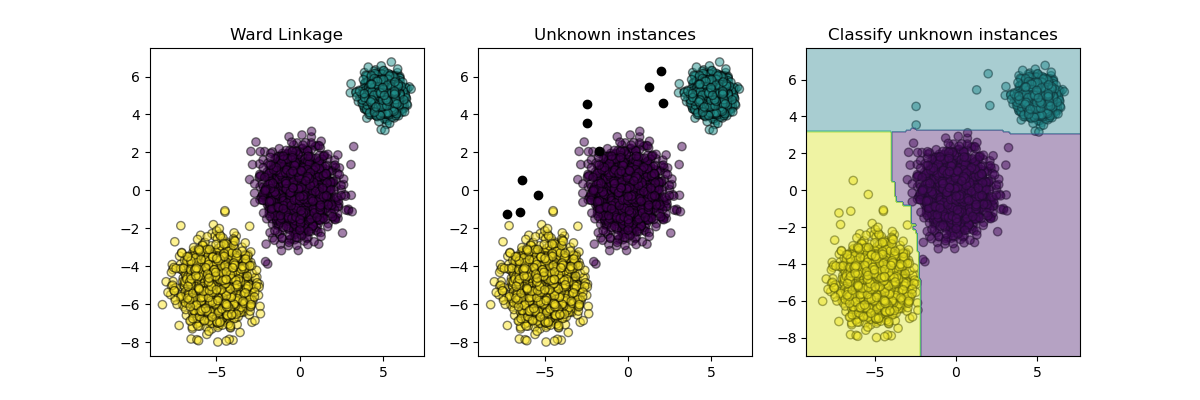Nota
Haz clic aquí para descargar el código completo del ejemplo o para ejecutar este ejemplo en tu navegador a través de Binder
Agrupamiento Inductivo¶
El agrupamiento puede ser costoso, especialmente cuando nuestro conjunto de datos contiene millones de puntos de datos. Muchos algoritmos de agrupamiento no son inductivos y, por tanto, no pueden aplicarse directamente a nuevas muestras de datos sin volver a calcular el conglomerado, lo que puede resultar intratable. En cambio, podemos utilizar el agrupamiento para aprender un modelo inductivo con un clasificador, lo que tiene varias ventajas:
permite a los conglomerados escalar y aplicarse a nuevos datos
a diferencia de reajustar los conglomerados a las nuevas muestras, se asegura que el procedimiento de etiquetado sea consistente a lo largo del tiempo
nos permite utilizar las capacidades inferenciales del clasificador para describir o explicar los conglomerados
Este ejemplo ilustra una implementación genérica de un metaestimador que extiende el agrupamiento induciendo un clasificador a partir de las etiquetas del conglomerado.

# Authors: Chirag Nagpal
# Christos Aridas
print(__doc__)
import numpy as np
import matplotlib.pyplot as plt
from sklearn.base import BaseEstimator, clone
from sklearn.cluster import AgglomerativeClustering
from sklearn.datasets import make_blobs
from sklearn.ensemble import RandomForestClassifier
from sklearn.utils.metaestimators import if_delegate_has_method
N_SAMPLES = 5000
RANDOM_STATE = 42
class InductiveClusterer(BaseEstimator):
def __init__(self, clusterer, classifier):
self.clusterer = clusterer
self.classifier = classifier
def fit(self, X, y=None):
self.clusterer_ = clone(self.clusterer)
self.classifier_ = clone(self.classifier)
y = self.clusterer_.fit_predict(X)
self.classifier_.fit(X, y)
return self
@if_delegate_has_method(delegate='classifier_')
def predict(self, X):
return self.classifier_.predict(X)
@if_delegate_has_method(delegate='classifier_')
def decision_function(self, X):
return self.classifier_.decision_function(X)
def plot_scatter(X, color, alpha=0.5):
return plt.scatter(X[:, 0],
X[:, 1],
c=color,
alpha=alpha,
edgecolor='k')
# Generate some training data from clustering
X, y = make_blobs(n_samples=N_SAMPLES,
cluster_std=[1.0, 1.0, 0.5],
centers=[(-5, -5), (0, 0), (5, 5)],
random_state=RANDOM_STATE)
# Train a clustering algorithm on the training data and get the cluster labels
clusterer = AgglomerativeClustering(n_clusters=3)
cluster_labels = clusterer.fit_predict(X)
plt.figure(figsize=(12, 4))
plt.subplot(131)
plot_scatter(X, cluster_labels)
plt.title("Ward Linkage")
# Generate new samples and plot them along with the original dataset
X_new, y_new = make_blobs(n_samples=10,
centers=[(-7, -1), (-2, 4), (3, 6)],
random_state=RANDOM_STATE)
plt.subplot(132)
plot_scatter(X, cluster_labels)
plot_scatter(X_new, 'black', 1)
plt.title("Unknown instances")
# Declare the inductive learning model that it will be used to
# predict cluster membership for unknown instances
classifier = RandomForestClassifier(random_state=RANDOM_STATE)
inductive_learner = InductiveClusterer(clusterer, classifier).fit(X)
probable_clusters = inductive_learner.predict(X_new)
plt.subplot(133)
plot_scatter(X, cluster_labels)
plot_scatter(X_new, probable_clusters)
# Plotting decision regions
x_min, x_max = X[:, 0].min() - 1, X[:, 0].max() + 1
y_min, y_max = X[:, 1].min() - 1, X[:, 1].max() + 1
xx, yy = np.meshgrid(np.arange(x_min, x_max, 0.1),
np.arange(y_min, y_max, 0.1))
Z = inductive_learner.predict(np.c_[xx.ravel(), yy.ravel()])
Z = Z.reshape(xx.shape)
plt.contourf(xx, yy, Z, alpha=0.4)
plt.title("Classify unknown instances")
plt.show()
Tiempo total de ejecución del script: (0 minutos 2.367 segundos)
